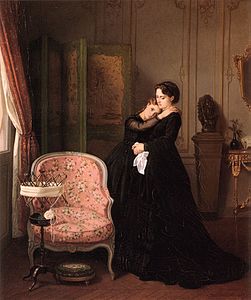Auguste Toulmouche
Auguste Toulmouche (born September 21, 1829 in Nantes , † October 16, 1890 in Paris ) was a French genre painter.
Life
Auguste Toulmouche was a son of Émile Toulmouche and his wife Rose Sophie, nee Mercier. Little is known about his childhood and youth. He lived with his parents and his four years older brother Émile at the address 12 bis , rue de La Fosse in Nantes, before the family moved into a new domicile at 33, rue de la Bastille.
Auguste Toulmouche had an uncle named René , who was a sculptor and possibly gave him initial ideas. Toulmouche was trained in Nantes from 1841 with René Amédée Ménard and later with a portrait painter named Biron. In 1846 he moved to Paris and studied with Charles Gleyre . In 1852 his painting La Jeune Fille was accepted in the salon, received a prize and was used by Emperor Napoleon III. bought. The following year, Empress Eugénie bought another painting by Toulmouche. The subject of this picture was the first step of a toddler. Toulmouche specialized in such representations from the domestic area with mothers and children or with young girls, which were very popular with customers. He continued to exhibit in the salon and again received a medal in 1861.
In 1862 he married Marie Lecadre, a relative of Claude Monet . As a mentor was being sought for the young Claude Monet at the time to accompany his studies in Paris, Toulmouche was given this task. He introduced Monet to Gleyre, whose academic style, however, soon no longer suited him. Through Gleyre, however, Monet met Impressionists such as Pierre-Auguste Renoir , Alfred Sisley and Frédéric Bazille , whom he soon followed closely.
Toulmouche, who became a Knight of the Legion of Honor in 1870 , remained true to his academic style, but certain connections seem to exist between his later works, from around 1870 onwards, and those of Monet. Toulmouche's colors brightened under Monet's influence; his afternoon idyll from 1874 shows Japanese elements and Monet's portrait of Camille Doncieux as La Japonaise from 1875/76 is not entirely dissimilar to the “délicieuses poupées de Toulmouche”, as Zola called them. Toulmouche left Paris in 1871 and moved with his wife to the Abbaye Notre-Dame de Blanche-Couronne, which soon became a meeting place for numerous artists.
His pictures were coveted by French as well as American collectors; In 1877 he was featured in an article on French art in Harper's New Monthly Magazine. In 1878 one of his pictures was awarded a third prize at the world exhibition in Paris . Still, his genre paintings gradually went out of fashion. It is possible that Toulmouche ran into financial difficulties because he sold his collection of antiques and statuettes in 1877. He died in 1890, just two years after his father, in his apartment on rue Victor Massé in Paris.
Toulmouche's works are in the Louvre , the Musée des Beaux-Arts in Nantes, the Museum of Fine Arts in Boston, and the Sterling and Francine Clark Art Institute , Williamstown, Massachusetts .
- Auguste
Web links
Individual evidence
| personal data | |
|---|---|
| SURNAME | Toulmouche, Auguste |
| BRIEF DESCRIPTION | French genre painter |
| DATE OF BIRTH | September 21, 1829 |
| PLACE OF BIRTH | Nantes |
| DATE OF DEATH | October 16, 1890 |
| Place of death | Paris |












